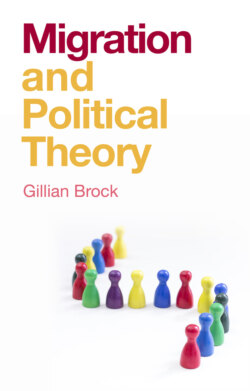Читать книгу Migration and Political Theory - Gillian Brock - Страница 27
2.3 Conclusions
ОглавлениеAs we have seen in this chapter, two works in political theory have been especially influential in contemporary theorizing about migration. Michael Walzer (1983) defends the right of states to limit migration and, in response, Joseph Carens (1987) argues for generally open borders. We also discussed many of the other prominent theorists who have weighed in on these issues, including arguments from Christopher Heath Wellman, Phillip Cole, David Miller, Ryan Pevnick, Mathias Risse, and Michael Blake and we see how a lively contemporary debate continues on these core themes.
As we have also seen, people defend a range of views under the description of “open borders.” Many of the accounts characterized as “open borders” are really more accurately described as arguing for “fairly open borders” because they permit states to exclude (for instance) known terrorists or to close their borders when a situation of welfare overload has been reached or is foreseeable. We could generally see all the types of arguments we have been considering as positioned along a continuum from “more closed” at one end to “more open” at the other. Even those commonly aligned with an open borders position allow some permissible constraints. And even those who defend reasonably strong rights to close borders argue that there are important constraints on state rights to exclude, such as those presented by requirements concerning how to treat refugees or guest workers, all topics to be studied in greater detail in other chapters of this book.
As we have seen in this chapter, the right to control admissions raises issues about the nature of political communities and membership, whether embracing a public culture is important to sustaining communities and if so what measures may be taken to protect it. It also invites us to think about who we are, what we ought to value, and the standing of borders. In beginning to address such issues, we have introduced the need for further discussion on a range of issues such as the nature of political community, whether national identity or culture have any roles to play in sustaining democracies, normative limits on rightful authority to exclude from a territory, and ownership of the earth’s resources. While these topics have been introduced in this chapter, further discussion of many key ideas will weave through several other chapters as well. So while readers might well have views about the strengths and weaknesses of arguments presented in this chapter, they are encouraged to remain open to revising their positions in the light of debates to follow. Later chapters take stock of how all these further topics should bear on rights to exclude and responsibilities to admit.
1 * Surprisingly little is still known about these victims. For some information see BBC News, “Essex lorry deaths: People found dead were all Vietnamese,” November 1, 2019, available here: https://www.bbc.com/news/uk-england-essex-50268939.
2 * While it is expected that readers will have a reasonably good understanding of what the idea of self-determination involves, for those who are interested in exploring some of the issues that this idea can present, see David Miller (2020). For instance, some of the core questions that may be puzzling include: Is the idea of self-determination an illusion? Does scope for self-determination genuinely exist in our globally interconnected world? Who are the people who should be self-determining? What if those people don’t agree on how to be self-determining? Why should we value self-determination?
